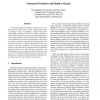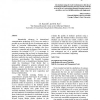93 search results - page 3 / 19 » Can Order of Access to Learning Resources Predict Success |
AIED
2011
Springer
12 years 10 months ago
2011
Springer
Narrative-centered learning environments introduce novel opportunities for supporting student problem solving and learning. By incorporating cognitive tools into plots and characte...
ICMLA
2009
13 years 4 months ago
2009
In structured prediction problems, outputs are not confined to binary labels; they are often complex objects such as sequences, trees, or alignments. Support Vector Machine (SVM) ...
ACSW
2007
13 years 8 months ago
2007
A semantically driven Virtual Organisation (VO) model for predicting important events for coral reefs is presented – the Semantic Reef. The model is an application of a Semantic...
IJET
2007
13 years 7 months ago
2007
Remarkable advances in instructional communication technology (ICT) have now made is possible to provide high levels of enrichment and the kinds of curricular differentiation that...
KDD
2010
ACM
13 years 11 months ago
2010
ACM
An ensemble is a set of learned models that make decisions collectively. Although an ensemble is usually more accurate than a single learner, existing ensemble methods often tend ...



